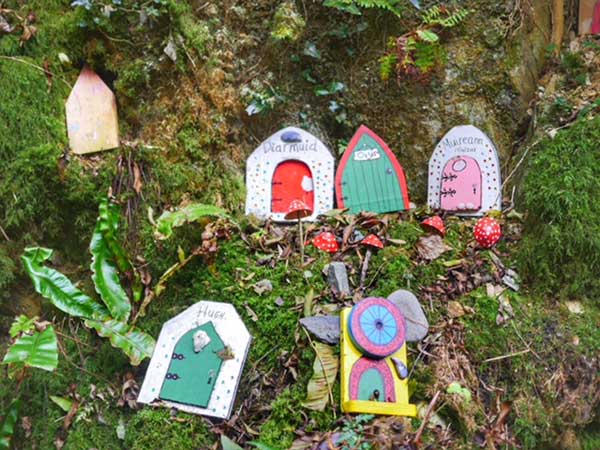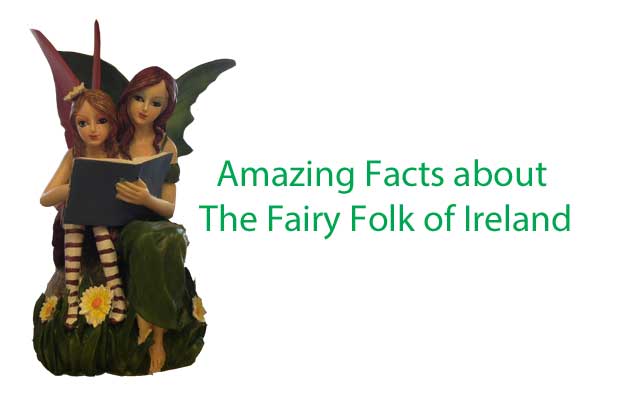The Fairy Folk of Ireland, their enchanting and sometimes horrific tales surrounding their supernatural activities have mesmerized and entranced countless generations of Irish throughout our long and sometimes bloody history. Fairy’s have been a way of explaining the unexplainable and were often blamed for the most sadistic, horrific and bloody deeds of mankind. To blame a supernatural entity was a way of explaining some events that made no sense in the human mind.
To understand fairies and their tales it is important to understand that like humans they came in good forms and other fairy courts were as dark as night with them representing pure evil. Fairy folk in Irish traditions can be the evilest of creatures with dark actions that have made their mark in the world through some of their sadistic and cruel actions. Ireland, in essence, is a land of tradition holding onto many of our Ancient Pagan beliefs, also reflecting the many conquerors that influenced our tradition in Mythology, a fluid and moving tradition that adapted and developed with other nationalities that came to these shores, such as the Vikings.
Adapting some of our cultural tales with creatures from Norse Mythology. Fairies in the Irish Traditions have attributes that are the same attributes as the humans telling their tales. Some are good, and some are bad, but like of most entities in the supernatural, their personalities are to the extreme. Throughout the Celtic influenced countries including Ireland, Scotland and Wales there are many shared tales of fairies and their different classifications and the folklore surrounding them.
In Scottish Tradition, which is adopted into Irish Fairy lore, there are two fairy courts, and they have very different attributes to each other, in fact, it could be said polar opposite personalities. These Courts of Fairies are known as the Seelie Court and the Unseelie Court. The Seelie Court of Fairies is associated with the happiness, brightness, luck and those who are blessed. The opposite is the Unseelie Court who is deeply associated with the unhappy, the misfortunate, and bad-tempered, darkness and evil. In its simplest form, these two courts signify light and dark beings, and they have the extreme characters that are associated with each of these differing realms of personality.
The tradition of telling Fairy stories is a major part of the cultural belief systems and traditions in Ireland. To have the ability to tell stories and tales associated with fairies is considered a wonderful gift, that not unlike the oral traditions of the Druids, have been passed down orally. In recent generations, these tales have been written down and are enchanting people throughout the world. These tales do not just include that stories of the enchanting wondrous Fairy Folk but also include epic tales of Giants, sea creatures, dark fairy entities and of course the naughty Leprechauns. These stories were traditionally told by one of the most important people in traditional Irish society, the Shanachie, which means a bearer of old lore. The Shanachie were not only storytellers they were a fountain of local knowledge and were essentially historians and genealogists. In Ireland, fairies were known as Faerie and are often collectively referred to as the little people (Not just Leprechauns).
Where do Fairies Live?
Most Irish natives especially those from country/rural areas will be able to tell you where the Aes Sidhe are located. Aes Sidhe are usually a mound or hill associated with the Fairy folk and is traditionally associated with where they lived. These mounds and hills dot the island of Ireland. It is wise to stay away from these areas, as it is said that all fairies good and bad are very protective of their homes and property associated with them. In bygone times people would not have entered these areas, nor would they have picked flowers from them or removed any earth, as this would anger the fairies and could result in the death of a family member. Fairy rings and bushes are still visible and are usually mentioned in the name of the towns land in some form. These fairy rings are associated with fairy rituals and areas where fairy’s gathered which were usually associated with nighttime actives. It is important to never enter a fairy ring as it can bring you bad luck.
There are countless tales that excite our imagination willing us to believe fairies and their good, as well as mischievous deeds. Some of these deeds include stealing our household goods while others are inevitably darker, they recount tales of stealing our children as well as human sanity. Some of Ireland’s most famous and beloved fairies are the Leprechauns’, traditionally cute little fellas dressed in green with a mischievous as well as bold personalities. These little people can be found in most stores in Ireland available for purchase in their fluffy inanimate forms.
Leprechauns of Ireland
However, in fairy lore, they are very animated little creatures that are said to reside at the end of rainbows where they greedily guard their pot of gold. Leprechauns are associated with the Irish Tuatha De Danann, the clan or tribe of the pagan Irish gods. However, they do not regularly appear in traditional Irish Mythology but become prominent in later Folklore and have become associated with the house of the fairies known as the Aos Si. They are usually depicted as little men who are usually wearing a green coat and hat as well as having golden buckles on their shoes. They are said to live in caves in fairy mounds and can be temperamental, even violent and aggressive. They are usually associated with drinking too much whiskey.
Tradition states that if you catch a Leprechaun, he will grant you three wishes in exchange for his freedom, but these wishes usually come at a great personal cost to the wish maker. Leprechauns are fairy cobblers and are said to be solitary creatures. In Irish tradition, it is best to leave these little creatures to their own devices, as they can be unpredictable and aggressive. The usual depiction of the Leprechaun we see today is thought to have developed in the 19th Century and is a form of unflattering satire of Irish Emigrants at this time. It is safe to say that our cuddly Leprechauns are one of our favourite exports.
Traditions of the Fairies
Some traditions say fairies are angels who decided to stay on earth, some who watch over and protect their families. However, there are some that say these fairies also have a dark side and some decided to stay on earth to fulfil a fairy curse and their existence was to torment future generations of the family that was the recipient of such a vile curse.
According to legends, fairies came to this realm, and to ensure their survival, they stole food, animals or even children. In Ireland, some stories state that they are our dead ancestors and the land of the fairies is where they live after death. The darker fairies in lore were said to cause illness, influence fertility and ruin crops. The legends of fairies were often used to explain events that could not be explained or to cover up foul events that were carried out by the hand of man.

It is important to remember when discussing the fairy tradition that fairies in their certain courts brought good luck and some bad luck. Good luck came to people who were good to the fairy folk and performed rituals and kindness towards them, which included leaving food out for them. While people who displeased them were inflicted with shocking sickness and misfortune.
The shamrock and four-leaved clover protected you from the displeasure of the bad fairies. Daisies were often used to protect children from being kidnapped and carried off into the darkness of the fairy realm. In Ireland, we have a very unusual fairy that is known as Pookas. They could bring both good and bad luck and were most feared in the country and rural seaside areas, inflicting terrible poor fish catches and poor crop harvests. The Pookas were shapeshifters and could change at will, making them terrifying.
They could appear as animals as well as take human form, meaning strangers were often looked upon with distrust, as they could have been a Pooka in its shifting form. Traditionally they were said to be a small animal like creatures of high intelligence with a pale appearance and white fur. They were known to cause trouble, do harm and play tricks on people. They were said to have the ability to stop hens lying and to turn milk sour
The Banshee or Fairy woman is one of Irelands most famous and feared fairy creatures. It is said that when you heard the cry of the Banshee someone in your family was about to die, she was the vile foreteller of death. Banshees were traditionally attached to family’s, and she was the result of a scorned woman, or she could also have been the result of a curse that was put upon a family, forever haunting the living by foretelling the imminent death of your loved one.
We all understand that fairies are tiny creatures that appear in many different forms from little-winged creatures to terrifying monster-like creatures and they have been the subject of literature, folk tales and mythology for countless generations.
They are immortalised in children’s books and feature films both sweet and gruesome. They are also depicted in Mythology as sea beings such as Nymphs and Mermaids. In Greek Metrology they are known as Nymphs, and William Shakespeare wrote about them in Midnight Summer Dream. Homer wrote about them in the Iliad.
Fairies in Norse Metrology
In Norse metrology, fairies are known as elves. All Mythological cycles seem to have some form of creature that can be associated with our traditional view of the fairy. In other Irish traditions, fairies took the form of Sea creatures or Selkies. These were people who lived under the sea.
When they left the sea, they shed their marine skin and then had human form usually of the most beautiful kind. Sometimes the skin was stolen by humans, and the Selkie woman lost her powers. If she found the skin, she could return to the sea. In Irish, the mermaid was known as ‘Muir Oigh’. These mermaids were said to have had beautiful long flowing red hair. Their beautiful song lured boats onto the rocks, and the sailors drowned. Colin Farrell starred in the movie the Legend of Merrow in Ondine. Many stories are written about fairies in Ireland such as those written by the famous Irish writer and poet WB Yates and Lady Gregory.
Are Fairies Friendly or Dangerous?
In short fairies are bringers of truthfulness, loyalty and generosity to travellers who respect them and their sacred places. On the other hand, they dislike meanness, selfish people and anyone who trespassers on their lands. Fairies were kept happy by leaving food and water out for them, which also stopped them from stealing more valuable items from your home. It can be stated that if you leave them in peace they will not come to harm you but it is important to keep them at bay with items that they like and they are lovers of tradition.
Never pick flowers or mushrooms from sites associated with the fairy folk as they may follow you home. Our ancient traditions such as Beltaine and Samhain are all associated with ancestor worship and the appeasing of otherworldly peoples including the fairy folk. They are a beautiful part of our traditional folklore that will forever remain part of who we are as a people and our traditions, which are deeply rooted in which the fairy folk are of major importance.

